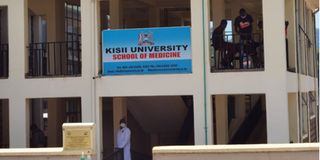Premium
Inside a human anatomy lab: Corpses and science in Sh92m Kisii complex

Kisii Teaching and Referral Hospital.
What you need to know:
- Doctors say they are treated with formaldehyde, a very strong preservative.
- Corpses sold like hot cakes in medical schools, partly driven by the growth of cities.
The 1985 horror movie, The Doctor and the Devils, takes us to 19th Century England where two grave robbers supply a wealthy physician with bodies to research anatomy on.
It’s based upon the true story of two men who killed 16 people and sold their bodies for anatomical dissection. When the truth outs, the poor doctor sighs: “Now my name shall be used to scare children in the future!”
Bizarre as it may seem, it is impossible to train doctors without the benefit of human cadavers for practicals. Grave robbing, or ‘body snatching’ was once a lucrative business. Corpses sold like hot cakes in medical schools, partly driven by the growth of cities.
Police ignored such cases and lawyers argued that because the previous ‘occupant’ had vacated such a body, its ownership was in doubt. Needless to say, body snatching flourished and criminals terrorised graveyards. The primary buyers were universities, which used cadavers in anatomy classes.
Fast-forward to the 21st Century, trainee doctors no longer have to struggle for corpses. If you visit any medical college, you are likely to see young glowing faces in white coats wielding scalpels in anatomy labs, hungry for practical lessons.
Future doctors
The Kisii Teaching and Referral Hospital (KTRH), for instance, has a modern lab that has tremendously transformed the institution. Here, there are plenty of cadavers for future doctors and scientists. Human skeletons and dried bones occupy prominent locations in the lab.
Today, there are six cadavers. Some are about two years old, yet so fresh. Doctors say they are treated with formaldehyde, a very strong preservative. They also use other embalming chemicals, such as phenol, methanol and glycerine in various proportions.

Mr Jared Obwoge (left) a professional mortician trains Kisii University medical students.
While commissioning this Sh92 million medical complex a couple of years ago, President Kenyatta said it would provide modern training facilities and boost healthcare. It also has a mortuary as well as histology and pathology units.
“The human anatomy lab has enabled our students to get quality education. The county government leadership worked well with the university administration to establish the centre,” says Dr Raymond Oigara, chairman of the department of human anatomy at Kisii University. The School of Medicine is headed by Dr Wycliffe Mogoa.
Locals have had mixed reactions over the complex with some saying the 100-body capacity morgue was a waste of public resources.
“The complex is a health development milestone in this part of the country. We get most of the bodies from the City Mortuary. It’s not easy as it involves the acquisition of unclaimed bodies through a legal process,” says Dr Oigara, who is a consultant surgeon.
“We are, however, moving to a digital era where students will have to learn about virtual anatomy. Technology is moving fast; this is already happening in developed countries.”
The university is working with other institutions in the world to digitise its labs and give students the latest skills in medicine.
“It is quite expensive to run a human anatomy lab because it needs lots of resources. The virtual anatomy will be cheaper and that’s why we are now working with other institutions to meet this goal,” offers Dr Oigara.

Dr Raymond Oigara who is the chairman of the department of Human Anatomy at Kisii University.
Mr Jared Obwoge, a mortician who teaches at the university, says the complex has boosted the School of Medicine. There are 70 students, 35 in their first year while the others are second-years.
Governor James Ongwae says the county government built the complex to boost medical research and encourage more Kenyans to pursue medicine.
“The labs occupy two floors of the new structure that we have donated to the university to support training. Our aim is to produce excellent doctors and scientists in Kisii,” he says.
A funeral chapel constructed near the morgue is also operational “to provide spiritual nourishment” to the bereaved.
“We have a chapel used by relatives and friends of the departed. We have employed a pastor who spiritually encourages the bereaved families before transporting their beloved ones home for the final rites,” says Mr Ongwae.
KTRH serves over six million people drawn from the neighbouring counties of Homa Bay, Migori, Narok, Nyamira and Bomet.





